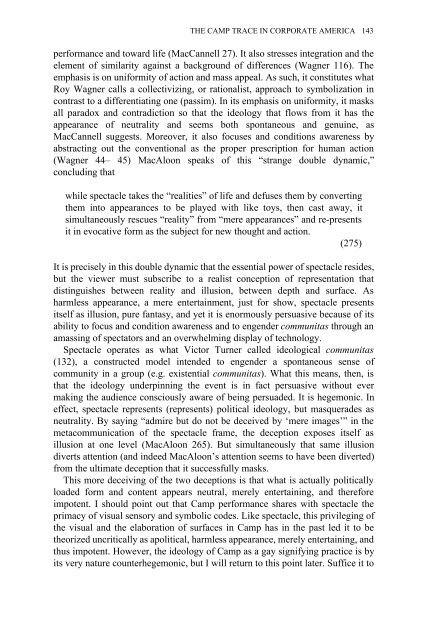Edited by Moe Meyer - Get a Free Blog
Edited by Moe Meyer - Get a Free Blog
Edited by Moe Meyer - Get a Free Blog
Create successful ePaper yourself
Turn your PDF publications into a flip-book with our unique Google optimized e-Paper software.
THE CAMP TRACE IN CORPORATE AMERICA 143<br />
performance and toward life (MacCannell 27). It also stresses integration and the<br />
element of similarity against a background of differences (Wagner 116). The<br />
emphasis is on uniformity of action and mass appeal. As such, it constitutes what<br />
Roy Wagner calls a collectivizing, or rationalist, approach to symbolization in<br />
contrast to a differentiating one (passim). In its emphasis on uniformity, it masks<br />
all paradox and contradiction so that the ideology that flows from it has the<br />
appearance of neutrality and seems both spontaneous and genuine, as<br />
MacCannell suggests. Moreover, it also focuses and conditions awareness <strong>by</strong><br />
abstracting out the conventional as the proper prescription for human action<br />
(Wagner 44– 45) MacAloon speaks of this “strange double dynamic,”<br />
concluding that<br />
while spectacle takes the “realities” of life and defuses them <strong>by</strong> converting<br />
them into appearances to be played with like toys, then cast away, it<br />
simultaneously rescues “reality” from “mere appearances” and re-presents<br />
it in evocative form as the subject for new thought and action.<br />
(275)<br />
It is precisely in this double dynamic that the essential power of spectacle resides,<br />
but the viewer must subscribe to a realist conception of representation that<br />
distinguishes between reality and illusion, between depth and surface. As<br />
harmless appearance, a mere entertainment, just for show, spectacle presents<br />
itself as illusion, pure fantasy, and yet it is enormously persuasive because of its<br />
ability to focus and condition awareness and to engender communitas through an<br />
amassing of spectators and an overwhelming display of technology.<br />
Spectacle operates as what Victor Turner called ideological communitas<br />
(132), a constructed model intended to engender a spontaneous sense of<br />
community in a group (e.g. existential communitas). What this means, then, is<br />
that the ideology underpinning the event is in fact persuasive without ever<br />
making the audience consciously aware of being persuaded. It is hegemonic. In<br />
effect, spectacle represents (represents) political ideology, but masquerades as<br />
neutrality. By saying “admire but do not be deceived <strong>by</strong> ‘mere images’” in the<br />
metacommunication of the spectacle frame, the deception exposes itself as<br />
illusion at one level (MacAloon 265). But simultaneously that same illusion<br />
diverts attention (and indeed MacAloon’s attention seems to have been diverted)<br />
from the ultimate deception that it successfully masks.<br />
This more deceiving of the two deceptions is that what is actually politically<br />
loaded form and content appears neutral, merely entertaining, and therefore<br />
impotent. I should point out that Camp performance shares with spectacle the<br />
primacy of visual sensory and symbolic codes. Like spectacle, this privileging of<br />
the visual and the elaboration of surfaces in Camp has in the past led it to be<br />
theorized uncritically as apolitical, harmless appearance, merely entertaining, and<br />
thus impotent. However, the ideology of Camp as a gay signifying practice is <strong>by</strong><br />
its very nature counterhegemonic, but I will return to this point later. Suffice it to


